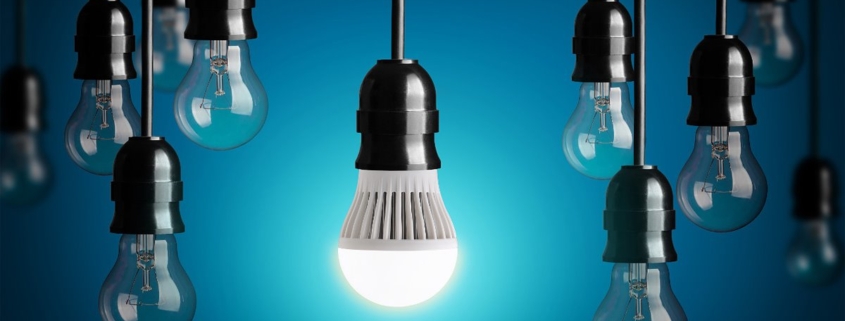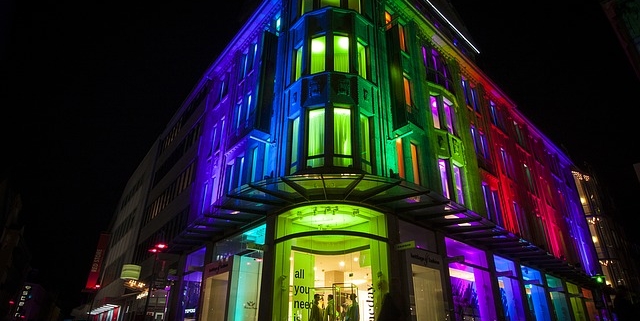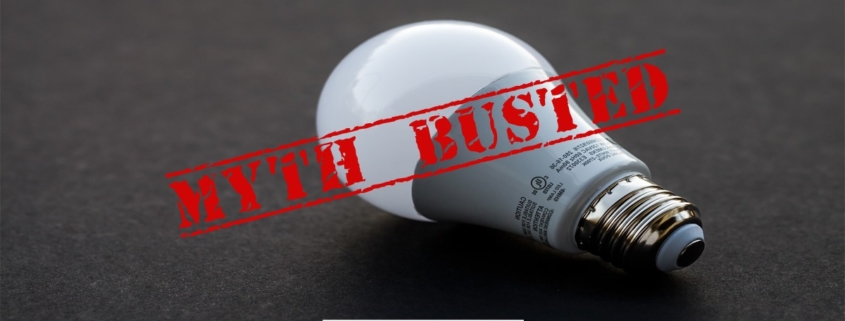Ever wonder how metal halide lights and Light Emitting Diodes (LEDs) compare? Well here’s a head-to-head comparison of the two followed by an in-depth discussion of each technology in turn.
Metal Halide Lights
What is a Metal Halide Light:
Metal halides are compounds formed when metal and halogen elements combine. They include things like sodium chloride (salt) and uranium hexafluoride (the fuel used in nuclear energy reactors). Metal halide lamps produce light by passing an electric current through a combination of mercury and metal halide gas. They function very similarly to other gas-discharge lamps (e.g. mercury vapor) – the principal difference being the composition of the gas. The introduction of metal halide vapor generally improves both the efficiency and the quality of the light.
What’s The Upside to Metal Halide Lights:
Metal halide lights are 3-5 times as efficient as incandescent bulbs and produce a much higher quality light. In many cases, and depending on the particular mix of metal halides, they have a very high color temperature (up to 5500K). This means that metal halide bulbs can be very useful for high intensity applications like vehicle headlamps, athletic facility illumination, or for photographic lighting. By far the best thing metal halides have going for them is the high quality light they output.
What are the Major Deficiencies in Metal Halide Lights:
Amongst the deficiencies in metal halide lighting are the following:
1. Metal halide lights have the longest warm-up period of any light on the market. Many metal halide lamps used in warehouses and sports facilities take 15-20 minutes just to reach their normal operating temperature. This is a major issues for several reasons:
○ They must be operated for longer periods of time than an LED because they do not switch on and off on demand.
○ You must anticipate when you need light.
○ Lights might be operated when they don’t have to be (for example during a 30 minute down period) to prevent them from needing the warm-up when turned back on.
2. Metal halide lights get less efficient when run at less than full operating power. The average bulb lasts around 6,000 to 15,000 operating hours. Depending on the particular bulb, you might spend around the same amount initially with LEDs and metal halides. The problem is that over time you will have to purchase a whole lot of metal halides (2-5) to equal the lifespan of a single LED. Overall that means very high maintenance costs over time.
What are the Minor Deficiencies in Metal Halide Lights:
Among the minor deficiencies in metal halide lighting are the following:
1. Metal halide lights are omnidirectional. Omnidirectional lights produce light in 360 degrees. This is a large system inefficiency because at least half of the light needs to be reflected and redirected to the desired area being illuminated. The need for reflection and redirection of light means that the output is much less efficient for omnidirectional lights due to losses than it would be for the same light if it were directional by its nature.
Where Are Metal Halide Lights Commonly Used:
Common applications for metal halide lighting includes large sport facilities like stadiums or hockey rinks as well as high bay lighting for warehouses and large indoor spaces.
LED:
What is a Light Emitting Diode (LED):
LED stands for Light Emitting Diode. A diode is an electrical device or component with two electrodes (an anode and a cathode) through which electricity flows – characteristically in only one direction (in through the anode and out through the cathode). Diodes are generally made from semiconductive materials such as silicon or selenium – solid state substances that conduct electricity in some circumstances and not in others (e.g. at certain voltages, current levels, or light intensities). When current passes through the semiconductor material the device emits visible light. It is very much the opposite of a photovoltaic cell (a device that converts visible light into electrical current).
What’s The Major Upside to LED Lights
There are four major advantages to LED lighting:
1. LEDs have an extremely long lifespan relative to every other lighting technology (including LPS and fluorescent lights but especially compared to metal halide lights). New LEDs can last 50,000 to 100,000 hours or more. The typical lifespan for a metal halide bulb, by comparison, is 12-30% as long at best (generally between 6,000 and 15,000 hours).
2. LEDs are extremely energy efficient relative to every other commercially available lighting technology. There are several reasons for this to include the fact they waste very little energy in the form of infrared radiation (heat), and they emit light directionally (over 180 degrees versus 360 degrees which means there are far fewer losses from the need to redirect or reflect light).
3. Very high light quality.
4. Very low maintenance costs and hassle.
What Are Minor Upside to LED Lights:
In addition to the major advantages, LED lights also offer several smaller perks. These include the following:
1. Accessories: LEDs require far fewer accessory lamp parts.
2. Color: LEDs can be designed to generate the entire spectrum of visible light colors without having to use the traditional color filters required by traditional lighting solutions.
3. Directional: LEDs are naturally directional (they emit light for 180 degrees by default).
4. Size: LEDs can be much smaller than other lights (even incandescent).
5. Warm-Up: LEDs have faster switching (no warm-up or cool-down period).
What’s The Downside to LED Lights?:
Considering the upside you might think that LED lights are a no-brainer. While this is increasingly becoming the case, there are still a few tradeoffs that need to be made when you choose LED:
In particular, LED lights are relatively expensive. The up-front costs of an LED lighting project are typically greater than most of the alternatives. This is by far the biggest downside that needs to be considered. That said, the price of LEDs are rapidly decreasing and as they continue to be adopted en masse the price will continue to drop. That all said the up-front cost of LEDs when compared to metal halide lights are actually fairly close. Both lights (depending on the specific model and specifications) typically sell for around $10-$30 per luminaire. Of course this can change in both cases depending on the particular light in question.
Where is LED Commonly Used:
The first practical use of LEDs was in circuit boards for computers. Since then they have gradually expanded their applications to include traffic lights, lighted signs, and more recently, indoor and outdoor lighting. LED lights are a wonderful solution for gymnasiums, warehouses, schools and commercial buildings. They are also adaptable for large public areas (which require powerful, efficient lights over a large area), road lighting (which offer significant color advantages over low and high pressure sodium lights), and parking lots.
Further Qualitative Comparison
What’s The Difference Between Metal Halide and LED Lights:
The two different technologies are entirely different methods of producing light. Metal halide bulbs contain metals that are evaporated into inert gas within the glass casing while LEDs are a solid state semiconductor technology. Both technologies produce a very high quality light. LEDs tend to last much longer and are a more energy efficient and less maintenance intensive technology. Metal halides have long warm-up periods and a shorter lifespan but produce a very high quality light and are one of the most efficient lights when it comes to very cool color temperature outputs.
Why would LEDs put metal halide bulbs out of business:
Some metal halide lamps have long warm-up periods (15-20 minutes) when the light is first turned on or in the event that the power source is interrupted. Additionally, there is a small risk that a metal halide lamp can explode. Although this is rare and there are preventive measures that reduce risk, there is still the possibility of injury or damage as a result. Typical preventive measures include changing bulbs prior to their expected end of life and en-masse as a group (versus spot changing single bulbs that actually fail). This can significantly increase costs and significantly shorten the useful lifespan of the light.
Additionally, metal halide bulbs are inefficient energy consumers. On top of this, they need to be run for much longer periods of time than actually needed due to the warm-up requirement. This all translates to cost (generally manifested as a higher utility bill). Although they cost about the same as LEDs, metal halide bulbs will keep adding expenses over time based on the inefficient way in which they operate and the frequency with which they must be replaced. In a large-scale building (like a warehouse, hockey rink, or stadium), this inefficiency will really add up.
Metal Halide vs LED Comparison:
• Correlated Color Temperature
○ LED Notes
LEDs are available in a wide range of color temperatures that generally span from 2200K-6000K (ranging from “warm” yellow to light or “cool” blue).
○ Metal Halide Notes
Metal halide lamps generate a very cool white light. They are available in color temperatures as low as 3000K. Some metal halides are available with extremely cool color temperatures up to 20,000K.
• CRI
○ LED Notes
CRI for LED is highly dependent on the particular light in question. That said, a very broad spectrum of CRI values is available ranging generally from 65-95.
○ Metal Halide Notes
Metal halides are perhaps the best source of high CRI white light on the market.
– Winner Metal Halide
• Cycling (Turning On/Off)
○ LED Notes
LEDs are an ideal light for purposely turning on and off because they respond rather instantaneously (there is no warm up or cool down period). They produce steady light without flicker.
○ Metal Halide Notes
Metal Halide lights require a notoriously long warm up period. Many stadiums have traditionally relied on metal halide lights but the bulbs can take 15-30 minutes to get to full operating power.
– Winner LED
• Dimming
○ LED Notes
LEDs are very easy to dim and options are available to use anywhere from 100% of the light to 0.5%. LED dimming functions by either lowering the forward current or modulating the pulse duration. LED lights are not compatible with traditional incandescent dimmers (which lower the voltage sent to the light) so you need to purchase LED dimmer switches as well if you want to dim.
○ Metal Halide Notes
Metal halide lights can be dimmed through the use of different electric or magnetic ballast but the process changes the voltage input to the light and can consequently alter the light characteristics. Generally speaking metal halide lights are less efficient when run at less than full power. In some cases dimming can also cause the light to prematurely expire.
– Winner LED
• Directionality
○ LED Notes
LEDs emit light for 180 degrees. This is typically an advantage because light is usually desired over a target area (rather than all 360 degrees around the bulb). You can read more about the impact of directional lighting by learning about a measurement called “useful lumens” or “system efficiency.”
○ Metal Halide Notes
Metal Halide lights are omnidirectional meaning they emit light for 360 degrees. Much of these emissions must be reflected and/or redirected which means losses and lower overall system efficiency.
– Winner LED
• Efficiency
○ LED Notes
LEDs are very efficient relative to every lighting type on the market and extremely efficient relative to incandescent bulbs. Typical source efficiency ranges 37 and 120 lumens/watt. Where LEDs really shine, however, is in their system efficiency (the amount of light that actually reaches the target area after all losses are accounted for). Most values for LED system efficiency fall above 50 lumens/watt.
○ Metal Halide Notes
Metal Halide lights have average efficiency (75-100 lumens/watt source efficiency). They lose out to LEDs principally because their system efficiency is much lower (<30 lumens/watt) due to all of the losses associated with omnidirectional light output and the need to redirect it to a desired area.
– Winner LED
Efficiency Droop
○ LED Notes
LED efficiency drops as current increases. Heat output also increases with additional current which decreases the lifetime of the device. The overall performance drop is relatively low over time with around 80% output being normal near the end of life. Recent advances by researchers who have identified the reasons for droop in LEDs look to reduce losses even further.
○ Metal Halide Notes
Metal Halide lights also experience efficiency losses as the device ages and additional current is required to achieve the same lighting output. Efficiency losses are greater than LEDs and the degradation time shorter in the case of Metal Halides.
– Winner LED Note: recent advances in LEDs will likely improve their droop qualities.
• Emissions (In the Visible Spectrum)
○ LED Notes
LEDs produce a very narrow spectrum of visible light without the losses to irrelevant radiation types (IR, UV) or heat associated with conventional lighting, meaning that most of the energy consumed by the light source is converted directly to visible light.
○ Metal Halide Notes
Metal Halide lights produce relevant amounts of both IR and UV radiation.
– Winner LED
• Infrared
○ LED Notes
None
○ Metal Halide Notes
Metal Halide lights emit IR radiation which is a waste of energy for the purposes of regular illumination.
– Winner LED
• Ultraviolet
○ LED Notes
None
○ Metal Halide Notes
Metal Halide lights emit UV radiation and require a filter built into the bulb to keep these emissions from being radiated into the atmosphere. These filters are required to prevent fading of dyed surfaces exposed to metal halide light otherwise serious damage can occur to light fixtures or even human beings and animals (e.g. serious sunburn or arc eye).
– Winner LED
• Heat Emissions
○ LED Notes
LEDs emit very little forward heat. The only real potential downside to this is when LEDs are used for outdoor lighting in wintery conditions. Snow falling on traditional lights like HID will melt when it comes into contact with the light. This is usually overcome with LEDs by covering the light with a visor or facing the light downward towards the ground.
○ Metal Halide Notes
Metal halide bulbs emit a significant amount of heat (roughly 10-15% of the total energy consumed is emitted as heat). In some circumstances this could be beneficial, however, it is a generally a bad thing as heat losses represent energy inefficiencies. The ultimate purpose of the device is to emit light, not heat.
– Winner LED
• Failure Characteristics
○ Led Notes
LEDs fail by dimming gradually over time. Because LED lights typically operate with multiple light emitters in a single luminaire the loss of one or two diodes does not mean failure of the entire luminaire..
○ Metal Halide Notes
Metal Halide lights exhibit an end-of-life phenomenon known as cycling where the lamp goes on and off without human input prior to eventually failing entirely. For this reason in many applications (such as a sporting stadium) metal halide lamps must be changed out prior to the end of their useful life.
– Winner LED
• Foot Candles
○ LED Notes
Foot candle is a measure that describes the amount of light reaching a specified surface area as opposed to the total amount of light coming from a source (luminous flux). LEDs are very efficient relative to every lighting type on the market. Typical source efficiency ranges 37 and 120 lumens/watt. Where LEDs really shine, however, is in their system efficiency (the amount of light that actually reaches the target area after all losses are accounted for). Most values for LED system efficiency fall above 50 lumens/watt.
○ Metal Halide Notes
Foot candle is a measure that describes the amount of light reaching a specified surface area as opposed to the total amount of light coming from a source (luminous flux). Metal halide lights are very efficient compared to incandescent lights (75-100 lumens/watt source efficiency). They lose out to LEDs principally because their system efficiency is much lower (<30 lumens/watt) due to all of the losses associated with omnidirectional light output and the need to redirect it to a desired area.
– Winner LED Note: Foot Candle ratings are very application specific and vary case by case so relative performance is difficult to generally quantify.
• Lifespan
○ LED Notes
LEDs last longer than any light source commercially available on the market. Lifespans are variable but typical values range from 25,000 hours to 100,000 hours or more before a lamp or fixture requires replacement.
○ Metal Halide Notes
Metal Halide lights have an better lifespan relative to old technology like incandescent lights but they have a short lifespan compared to LED. Typical lifespan values range from 6,000 hours to 15,000 hours before a bulb requires replacement. Note: sometimes metal halide lights need to be changed out before the end of their useful life to preempt serious degradation effects like color changes or cycling.
– Winner LED
• Lifetime Costs
○ LED Notes
LED lighting has relatively high initial costs and low lifetime costs. The technology pays the investor back over time (the payback period). The major payback comes primarily from reduced maintenance costs over time (dependent on labor costs) and secondarily from energy efficiency improvements (dependent on electricity costs).
○ Metal Halide Notes
Metal halide lights are relatively cheap to purchase but they are relatively expensive to maintain. Metal halide bulbs will likely need to be purchased several times and the associated labor costs will need to be paid in order to attain the equivalent lifespan of a single LED light.
– Winner LED
• Maintenance Costs
○ LED Notes
As a result of the operational lifetimes of LEDs and the frequency with which bulbs have to be changed out, LEDs are by far the best on the market in regards to lifetime costs.
○ Metal Halide Notes
Metal halide bulbs require regular relamping and ballast replacement in addition to the labor cost to monitor and replace aging or expired lights several times within the typical lifespan of a single LED.
– Winner LED
• Upfront Costs
○ LED Notes
LED light costs are high but variable depending on the specifications. The typical 100W-equivalent LED light costs somewhere between $10 and $20.
○ Metal Halide Notes
A 100W Metal Halide light costs somewhere between $10 and $30 per bulb depending on the specifications.
–
• Shock Resistance
○ LED Notes
LEDs are solid state lights (SSLs) that are difficult to damage with physical shocks.
○ Metal Halide Notes
Metal halide bulbs are relatively fragile. Perhaps more importantly, broken metal halide bulbs require special handling and disposal due to hazardous materials like mercury inside of many lights.
-Winner LED
• Size
○ LED Notes
LEDs can be extremely small (less than 2mm in some cases) and they can be scaled to a much larger size. All in all this makes the applications in which LEDs can be used extremely diverse.
○ Metal Halide Notes
Metal halide bulbs can be small but typically aren’t produced below roughly a centimeter in width. The size of the lamps is limited by the wattage and light output required for a given application.
– Winner LED
Temperature Tolerance
• Cold Tolerance
○ LED Notes
Minus 40 Degrees Celsius (and they will turn on instantaneously).
○ Metal Halide Notes
Minus 40 Degrees Celsius.
– Winner LED
• Heat Tolerance
○ LED Notes
100 Degrees Celsius. LEDs are fine for all normal operating temperatures both indoors and outdoors. They do, however, show degraded performance at significantly high temperatures and they require significant heat sinking, especially when in proximity to other sensitive components.
○ Metal Halide Notes
We couldn’t find any objective data on metal halide bulb performance in high temperature situations.
• Warm-Up Time
○ LED Notes
LEDs have virtually no warm-up time. They reach maximum brightness near instantaneously.
○ Metal Halide Notes
Metal halide lamps require a noticeable warm-up time that varies depending on the light. Metal halide lights for sporting stadiums might take 15-20 minutes to arrive at maximum brightness.
– Winner LED
• Warranty
○ LED Notes
Often 5 to 10 years.
○ Metal Halide Notes
Typically 1-2 years.
– Winner LED





